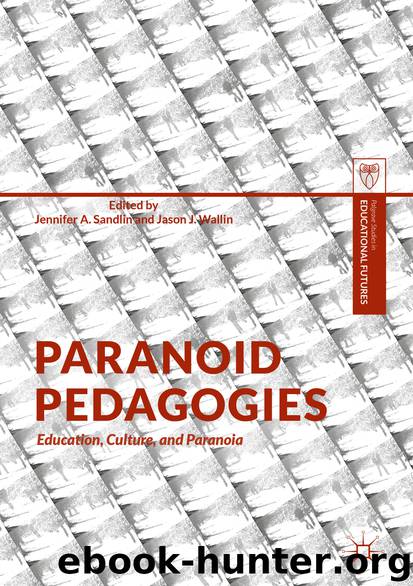Paranoid Pedagogies by Jennifer A. Sandlin & Jason J. Wallin

Author:Jennifer A. Sandlin & Jason J. Wallin
Language: eng
Format: epub
Publisher: Springer International Publishing, Cham
Paranoia in Social Studies: You Probably Think This Class is About You (And It Is)
This chapter begins from the premise that the curriculum of social studies education enacts what O’Donnell (2000) terms ‘cultural paranoia.’ This paranoia appears to students from their teachers, textbooks, and content standards as a ‘fiction that binds individual subjects to identificatory collective bodies such as those of the nation, class, gender (when articulated according to the logic of compulsory heterosexuality), and the “human”’ (p. 16). This type of paranoia focuses on ‘identity, knowle dge, and history’ and is validated for the paranoid social studies teacher ‘by what is out there’ (p. 16). The social studies teacher’s job is to explain the world to students in temporal, spatial, and cultural functional terms (analogous to disciplinary divisions within social studies for courses in history, geography, and psychology/sociology, respectively).
Social studies education uses paranoia to effect certain subjectivities (American, capitalist, patriotic, democratic, cosmopolitan, etc.) by situating, localizing, and pinning down student learners to a particular time and place in the world. In New York state’s standards , social studies is ‘the integrated study of the social sciences and humanities intended to promote civic competence…to help young people develop the ability to make informed and reasoned decisions for the public good as citizens of a culturally diverse, democratic society in an interdependent world’ (New York State Department of Education, 2012, p. 1). In the state of Michigan, the Detroit Public Schools use social studies education to provide its students with the ‘civic values necessary for fulfilling the duties of citizenry in a participatory democracy and to also effectively engage in the global society’ (Detroit Public Schools Office of Social Studies, 2012, p. 1). In these curriculum standards, social studies education will make students effective citizens as it ‘promotes’ certain worldviews while ignoring others, ‘develops competencies’, ‘fulfills’ the needs of a government to have citizens able to sustain its form and function, and ‘informs’ students to ‘engage’ in the global society. I reveal in this chapter how these work as paranoid tendencies, never far removed from a certainty of understanding how the world is and how it works. This notion of centrality asserts the individual student and its nation are at the center of life and exposes anxieties about events and ideas in the world that disabuse the surety of feeling both certain and centrally secure in one’s knowledge of and place in the world.
The cultural paranoia of social studies education is one that is complicit with—and upholds the tenets of—the State, embodying the concept of molarity Deleuze and Gu attari (1987) use to describe totalizing, universal ways of dividing and organizing knowledge, practices, and life itself (p. 33). Social studies carves up and maps out specific territories (of the world’s landscape, of the earth’s chronology, of a student’s life), through which the teacher presents what the world is, sorting human subjects and nonhuman objects into time periods via history, into cultures via anthropology, into regions via geography, into consumptive practices via economics, and so f orth (cf.
Download
This site does not store any files on its server. We only index and link to content provided by other sites. Please contact the content providers to delete copyright contents if any and email us, we'll remove relevant links or contents immediately.
The Art of Coaching Workbook by Elena Aguilar(50984)
Trainspotting by Irvine Welsh(21518)
Twilight of the Idols With the Antichrist and Ecce Homo by Friedrich Nietzsche(18503)
Fangirl by Rainbow Rowell(9095)
Periodization Training for Sports by Tudor Bompa(8170)
Change Your Questions, Change Your Life by Marilee Adams(7635)
This Is How You Lose Her by Junot Diaz(6794)
Asking the Right Questions: A Guide to Critical Thinking by M. Neil Browne & Stuart M. Keeley(5632)
Grit by Angela Duckworth(5521)
Red Sparrow by Jason Matthews(5390)
Paper Towns by Green John(5089)
Room 212 by Kate Stewart(5035)
Ken Follett - World without end by Ken Follett(4645)
Housekeeping by Marilynne Robinson(4344)
The Sports Rules Book by Human Kinetics(4290)
Double Down (Diary of a Wimpy Kid Book 11) by Jeff Kinney(4207)
Papillon (English) by Henri Charrière(4195)
The Motorcycle Diaries by Ernesto Che Guevara(4012)
Exercise Technique Manual for Resistance Training by National Strength & Conditioning Association(3955)
